“A Beautiful Habit.”

To get to Mysore from New York City takes roughly 30 hours. Between taxis and planes and layovers and delays I notice a sense of internal calm I haven’t felt before. This is my fourth trip. I’ve already done this three times. As my boyfriend says, it’s not a coincidence anymore… I’m not going to India on a whim. I’m consciously choosing to make this trek year after year after year.
I arrive in early morning of October 1st, stumble into a taxi and sleep for most of the 3.5 hours it takes to drive from Bangalore to Mysore. Sharp stops and turns and then,
“Madame! Sleeping? Mysore coming!” says my driver.
I pull myself upright and recognize the stretch of road we’ve entered. By the time we reach Gokulam (the neighborhood where I stay and where I practice Ashtanga Yoga), I’m ready for a proper nap.
I find my small studio apartment, shut the curtains, settle into another typically hard Indian bed, and snooze until the shala opens at 3:30pm for registration.
I have my passport photos ready and copies of my Indian Visa. I’ve printed my confirmation letter which grants me access into the increasingly in-demand shala. I have my rupees counted and stacked to pay tuition.
Because it’s the opening of the season (my teacher only opens the school for western students to practice for part of the year) it’s a week of led Primary Series classes to begin. Jetlag wakes me up at 3am the next morning. In the pre-dawn dark I make coffee and prepare for practice.
Class just feels right the next few days. Strong and soft at the same time. The shala rugs feel a faded shade of familiar. I place my mat in the front row and listen to my teacher chanting the opening mantra just a few inches away from me. I practice with a smile. I see friends from past seasons, meet new ones from all over the world, and surrender to jet lag. I get my only-in-India pink elephant print bed sheets out of storage and make my bed. I walk around with wonder still in my eyes at the sights and smells of India. I try a new Eggplant curry at lunch and marvel at how they’ve cooked the vegetable just right so it actually does melt in my mouth.
Right now everything feels comforting here. The familiar and the unfamiliar. I want to keep this beautiful habit of coming to India year after year…
As the week of Led Classes (classes during which our teacher calls out each posture and we practice together as a group) gives way to the regular classes (called ‘Mysore Style’ classes during which each student practices only the postures they have been taught, individually without a teacher leading) my back starts to ache. I see a sweet Canadian for acupuncture sessions and the pain slowly melts into comfort.
This year the day off is Sunday instead of Saturday as it has been in the past. Conference with our teacher, Sharath, is now on Saturday afternoon. It’s a small change that funnily enough has most of us wondering what day it is – constantly holding to that old, conditioned pattern of ‘the week.’
So we adapt to our new week and pile into the shala each Saturday to listen to Sharath’s wise words…
—
Some Conference Notes October 11, 2014
“Yoga is the greatest gift,” Sharath says to start this season at the shala. Words so simple and true we all smile softly in a reply to him.
He explains that yoga is special because of the breath and the vinyasa system, the art of placing the breath in a special way connected to your movement. This process of breathing and moving takes time to learn. It must be tuned like an instrument or like a singer might train to tune her voice.
Once one has learned to control the breath, automatically control of the mind happens.
Student questions begin to flood the room.
“Is it possible to practice with perfect vinyasa?”
Sharath says yes, it is possible and we are all working towards it. But this is something that you must do one posture at a time, slowly. At the beginning we might spend two weeks on just Surya Namaskar A and B. The first day to complete a sun salutation it takes 25 breathes! But the more we practice, the more we train to breath correctly, and over time we can complete it with one breath per movement, the nine vinyasas required to complete a sun salutation A.
A question about the importance of alignment prompts Sharath to remind us that of course the alignment of muscles and bones are important, but so are the movements, the breathing and the heat that this helps to create. These moving asanas help to purify the lungs and nervous system and create a spiritual transformation within us.
—
Some Conference Notes from October 18, 2014
During the second conference of the season Sharath reminds us that there is no recoded birth date for yoga. For as long as there has been this universe, there has been yoga.
Almost universally it is agreed that yoga is for calming and controlling the mind. These initial stages lead to deeper understanding and ultimately higher consciousness.
In order to begin to control the mind, Sharath spent time talking about the importance of the Ashtanga Tristana, the three points of focus. They are asana, pranayama (breathing, which brings control to the mind) and dristi.
Sharath specifically mentioned the power of the gazing point, dristi, and it’s ability to bring more focus to our practice. Our attention is always on others, on the outside. The more we bring the focus inside the more potential the practice has to become a meditative experience which can lay the groundwork for deeper spiritual growth.
Pranayama can be described as the expansion of prana. In one day we take 21,600 breaths, he says. But we can expand the breath. And if we can expand the breath we can expand our life.
The ancient risis knew this, he reminded us, because of many, many years of practice, research and experimentation. He told a story of Guruji’s village, Koushika, where the great sage Vishvamitra did many thousands of years of meditation and research. Now everyone is rushing, but this research takes time!
Sharath reminded us that “yoga cannot be described. Yoga cannot be purchased. Yoga is all that happens within you.” And without the yamas and niyamas asanas are useless. He spoke of the importance of especially satya, to be truthful to yourself and others and asteya, not to steal. He also mentioned ahimsa, nonviolence. He warned us that asanas make us strong and create heat, but it is extremely important not to misuse the strength!
One of the points that made the biggest impact on me was a question regarding the global community of teachers and practitioners and the unfortunate but sometimes unavoidable conflict and competition that arises. Sharath really encouraged the community to commit to be wise enough not to fight, and instead to unite. To have an internal focus and not worry about the actions of others. To not get worked up in politics and external distractions, but instead to correct our own actions and build a supportive community that way.
—
